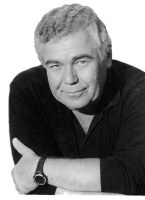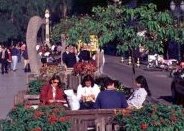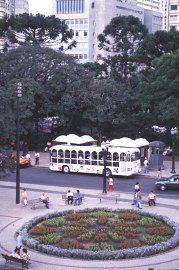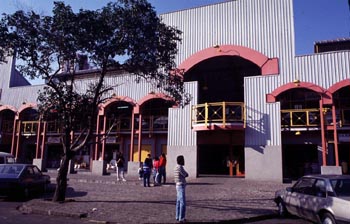Did you ever hear about Curitiba?
Sunday, 15th July 2001.
Did you ever hear about Curitiba?
Dario Fo & Franca Rame News...
The Sunday Chocolate of Dario Fo, Franca Rame & Jacopo Fo.
Translation: Loto Perrella.
No, until one week ago even we didn’t know this story. We have discovered it by reading «Natural capitalism»1, by Paul Hawken, Amory and Hunter Lovins. It is really incredible that nobody knows anything about it, because Curitiba is one of the greatest experiences of social change ever made.
Curitiba is not a small alternative community. It is a town with almost two million and a half inhabitants. It is located in south Brazil. It is not either a new story: it has been going on for the last thirty years. In 1971, under a full fascist dictatorship, a number of chance events caused the appointment of Jaime Lerner as mayor of the city. He had been chosen because he was a harmless architectural expert. A thirty-three year old who had never shown any political interest, and who appeared to be the ideal person to bring together the different factions on power.
It took some time for Jaime Lerner to get organized, then in 1972 he decided to create the first traffic island in the world. Lerner was aware that he had a good part of the city against him. Shopkeepers were terrified by the idea that their business would be damaged by the the prohibition for cars to enter the centre of town. And car owners hated the idea to have to walk to the town centre. Malevolent people said he was afraid his initiative would be blocked by an appeal to the Court. The fact is that works started on a Friday, one hour after the Court closed. A horde of workers filled the centre of the town and started to set up street lamps and flower boxes, to re-pave the streets and to dig the ground to plant trees. They worked without interruption during forty-eight hours. When the first gang collapsed it was substituted by a second squad of workers, and they carried on like that. On Monday morning, when the Court opened, the job was finished. We believe that no public works have been carried on so rapidly in the whole world history.

Jaime Lerner
Citizens of Curitiba stood open-mouthed. Thousands of flowering plants had been laid down. They had never seen anything like it. And people started to pull out the flowers to take them home. But Lerner had foreseen this, and there were gangs of gardeners who replaced immediately the flowers. After a few days the citizens stopped stealing the flowers. The shopkeepers, on the other hand were surprised to discover that the town centre, transformed into a salon, boosted their sales. And when the following Saturday a procession of cars from the Automobile-Club tried to invade the traffic island, it became impossible to do so because thousands of children were painting large paper strips laid about on almost all of the pavement. Since then, every Saturday the town children meet in the traffic island to fill with wonderful drawings enormous paper rolls stretched on the pavement.

A view of Curitiba
The second operation Lerner carried out was the creation of a revolutionary transport system with main streets reserved for buses and special access ramps covered with transparent tubes which put the side-walks on the same level as the public transport, which allowed people to get on the buses more quickly and without to have the climb steps. These ramps allowed accessing the public transport also to people on wheelchairs. A special attention was paid to connections with the poor districts of the town. They bought buses with three coaches, with larger doors which opened in connection with the sliding doors of the covered access ramps. To reduce costs and waste of time the conductors’ posts were also abolished and it was decided to trust the fact that, if transport works really well, citizens are happy to pay their ticket. Thanks to these changes the routes times of the Curitiba buses are three times quicker and in one hour they transport three times more passengers, with a relation between the money invested and the passengers transported of over 69%. In practice, they had created an extraordinary tube system under the open sky.

Tourist bus in Curitiba
The Curitiba public transports carry twenty thousand passengers per hour (more than those carried by the New York public transport). Every day buses cover a distance equal to nine times the tour around the world. Rio has an underground transport means which carries one fourth of these passengers and costs two hundred times more.
Thanks to this keen management of costs, the transport lines finance themselves with just the tickets price (about one thousand lire), they pay the costs of a fleet which has cost forty-five million dollars, they offer profits to the ten companies which have the service on contract and remunerate the invested capital with a profit rate of 12% yearly. The authorization granted to the managers of the service can be revoked instantly.
The banks, which are unwilling to cooperate with other local administrations, are very willing to leave money to the Curitiba town council. Transport is so efficient that in 1991 a fourth part of car drivers in town had given up owning a car, and 28% of passengers, even having a car, preferred not to use it. And this in spite of the fact that transit is very fluid and car jams are unknown.

Side entrance of the town market in Curitiba
This mass refusal of cars is also helped by the one hundred and sixty kilometres of bike lanes. For Lerner it was fundamental to start reforming the town from transport means, because he said that nothing influences more the citizens’ conscience than the efficiency of public transport.
But the reform did not stop with transports. They have faced the problem of the shantytowns and of poverty by finding simple systems in a position to offer immediate positive results and a radical change in the long term culture. The fancy of the solutions is most surprising. They seem crazy but they show an enormous effectiveness. There are daily services of meals distribution. They have built fourteen thousand council houses. But they have also distributed small patches of land to make kitchen gardens and to build houses. The building materials are bought through long term council’s funds which are paid back in monthly instalments equal to the price of two cigarette packets. Then, every new house receives from the town council the present of a fruit tree and a garden tree. The council also offers one hour counselling by an architect, to help the families to build more comfortable and harmonious houses. The poor districts in Curitiba are the most beautiful in the world.
There is a service of vans which goes about the town exchanging two kilos of separated garbage with purchase vouchers which allow to buy one kilo food (or notebooks, or books, or transport tickets). In this way, 96% of the town garbage is collected and recycled. This has allowed to spare millions of dollars to build and manage a garbage dump. Through the cleanliness of the town and an improved nourishment of the poor population they have achieved a clear health improvement.
The children’s death rate is one third with respect to the national one. There are thirty-six hospitals with four thousand five hundred beds, free medicines and medical assistance all over the territory. There are twenty-four telephone lines available to the inhabitants for all sorts of information. One of these offers to the poorer citizens the current prices of two hundred and twenty-two basic products. In this way consumers are sure not to fall victims to dishonest shopkeepers.
There are thirty district libraries with seven thousand books each. They are called «Knowledge lighthouses», and are small prefabricated houses with a white and red striped tube 15 meters high. On top of this there is a glass bubble from which a policeman controls that children and old people may reach the library without being disturbed. There are twenty theatres, seventy-four museums and cultural centres, and all of the one hundred and twenty schools in town offer evening courses.
They organize vocational training courses for ten thousand people per year. They are connected to a «Solidarity telephone» which allows collecting electric household appliances and used furniture, which are repaired by the crafts apprentices and resold at low prices in markets or given away.
Thanks to the microcredits, after learning a craft the young people can open up their own shop. There is help also for those who want to become pedlars through the permits granted to the trade. And it is the logic behind the way problems are faced which is different. For example, the action of a group of young hooligans who pulled off the flowers from the botanical gardens was interpreted as a call for help, and the youngsters were engaged as garden assistants.
Another of Lerner’s great initiatives has been that of creating tens of parks with small lakes and to plant trees all over the place. Curitiba is the greenest town in the world. In short, a paradise with 96% schooling (in 1996). The inhabitants with a higher education certificate are 83%. The town has one third less poor people than the rest of Brazil, and the life expectancy reaches seventy-two years, on average as much as in the USA but with a rent per capita which is only 27% that of the USA. Taking into consideration that it is a third world town, it isn’t bad...
The question here is, why the Curitiba experience is not known in Italy. We have made a research and were told that some years ago the magazine «Nuova Ecologia» published a long report on this miracle of creative honesty. And also the «Espresso» wrote about it. Then, why Curitiba has not become an example for others to imitate? Why these clever and exciting techniques have not been adopted by the Italian left wing parties? What happens to our politicians? Haven’t they got any practical sense? Are they ill of seriousness? Can’t they dream anymore?
Note:
1PS: «Natural Capitalism» is really an exceptional book, which tells all the practical experiences of energy and raw materials savings successfully carried out throughout the world. It points out that ours is not a consumers’ society but a squandering society.
Just imagine that, should the USA introduce the Japanese house building and manufacturing approach, they would save 200 billion dollars in energy every year. The book shows that by recycling and rationalising consumption, we could save as much as 95% of raw materials and energy.
And, beware: these savings wouldn’t imply higher building costs. There have even been houses built which don’t need central heating and air conditioning installations, and that have lower building costs than the conventional ones. And all these technologies are no novelty: they have already been tested for years, sometimes for tens of years.
This is to say that poverty, world starvation, pollution and destruction of the environment are not a matter of evil doing, but of stupidity.
We wish to support the diffusion of this book, therefore we have reached an agreement with the publisher, Edizioni Ambiente, to offer it in our sales areas. You may buy it on-line for 25,- Euros and receive it at home without any shipping expenses, either paying on delivery or through your credit card (http://www.commercioetico.it/Default.aspx).
Related Links:
The best president of Argentina: a historical article on Arturo Illia. Pablo Mendelevich. La Nación. Argentina. The club of lost books.
Publications of Lluís Maria Xirinacs. Life, work and thought.





